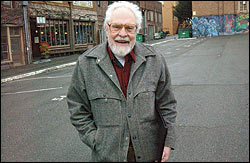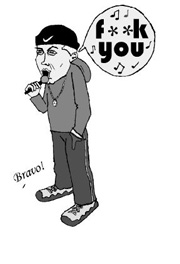Philip Thiel stands in the hall, alone, shaking his head. “They’re arranging deck chairs on the Titanic!” he grumbles.
In the adjoining room deliberates the Northwest Design Review Board, at the end of yet another public hearing Dec. 12 on the fate of a controversial new building at the corner of Northeast 42nd Street and 15th Avenue Northeast in the University District. Thiel, a retired professor at the University of Washington School of Architecture, and the groups he represents—the University District Community Council, the Roosevelt Neighbors’ Alliance, the University Park Community Club, the Seattle Community Council Federation, Cafe Allegro, and Magus Books—have been trying for the past 18 months to stop the project. It’s a six-story mixed-use building being developed by Unico Properties of Seattle, and it would fill the entire space now occupied by the parking lot across from Cafe Allegro.
Later, Thiel minced no words. “This is the worst project—the most damaging project—I’ve seen in 40 years.” He reels off his objections: The big-box design is incongruous with the adjoining gothic mass of the University Temple United Methodist Church; the bulk would loom over and destroy the ambience and views of the historic Cafe Allegro; it would disrupt a heavily trafficked pedestrian network; the high-end housing residents of the new building are likely to clash with the seven-night-a-week shelter for young homeless adults in the church basement. But mostly, Thiel says, “It’s just too big.”
Thiel’s groups have collected more than 2,500 petition signatures for an alternative plan that calls for an open plaza next to Cafe Allegro and a building half the size proposed by Unico. It has never been seriously considered. Unico rejects the proposal as not economically viable, and, as even Thiel notes, the review board “has been prejudiced from the start, but they have a very limited scope. They’re not concerned with major things like height and bulk. . . . Their remedies are very limited.”
The Unico property is not the only controversial development in the University District these days. On University Way (the Ave), north of Northeast 47th Street, half a block of small businesses is already mostly vacant in anticipation of massive expansion of the Wilsonian apartments. At Northeast 45th Street and Brooklyn Avenue Northeast, Safeco plans to build a second office tower. Across 45th, Sound Transit’s light-rail station will take out still more businesses. A row of old houses and a small motel on 12th Avenue Northeast between 47th and 50th streets is gone, now becoming fancy new housing and mixed-use buildings. Roosevelt Way Northeast, from 45th Street south to the University Bridge, is a canyonland of massive new buildings. The street is dead after 6 p.m. And, each year, there are fewer and fewer housing units in this student neighborhood that students can afford to rent.
Neighborhood activists like the Seattle Displacement Coalition’s John Fox have fought gentrification of the U District for years. But Fox says the pace of change has accelerated dramatically, often with little meaningful resident input, under the developer-driven agenda of Mayor Greg Nickels and after the City Council lifted development restrictions in the neighborhood in 2003. Unless such changes are mitigated, Fox says, “The existing character of the district will give way. Affordable housing will give way.”
Social service providers are also worried. Mainline Protestant churches in the neighborhood provide shelter, food banks, and other services to runaways and homeless young adults, services that aren’t available anywhere else in the city, except where they would have to mix with a sometimes predatory older population. In other cities, as more and more of what Unico and UW call “market rate” housing has supplanted lower-income housing, new residents have forced out social services that catered to less desirable residents. The U District’s young-adult program leaders fear that’s what might happen here.
The university plans to lease a full floor of office space in the new Unico building, and it has been a driving force behind plans to increase the U District’s density. So has the University District Chamber of Commerce. They and the mayor’s office argue that higher density prevents urban sprawl and gets people out of their cars. That’s very true. But one has to ask who is providing the higher density. In the case of the project at 15th and 42nd, Unico plans to market residential units to UW faculty and staff. They, and Safeco’s workers, can afford such luxury. Students cannot.
Where are UW’s students supposed to live? It’s a subset of a question relevant to the entire city these days. Our area’s semi-affordable housing migrates to South King County, and Seattle development is devoted almost entirely to “market rate” developments. Where are the poor supposed to go? And is a city unaffordable to a sizable chunk of our area’s residents really the city Seattle wants to become?







